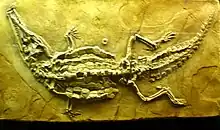| Mesoeucrocodylia Temporal range: Sinemurian - Recent, | |
|---|---|
 | |
| Notosuchus | |
| Scientific classification | |
| Domain: | Eukaryota |
| Kingdom: | Animalia |
| Phylum: | Chordata |
| Class: | Reptilia |
| Clade: | Archosauria |
| Clade: | Pseudosuchia |
| Clade: | Crocodylomorpha |
| Clade: | Solidocrania |
| Clade: | Crocodyliformes |
| Clade: | Mesoeucrocodylia Whetstone and Whybrow, 1983 [1] |
| Subgroups | |
| |
Mesoeucrocodylia is the clade that includes Eusuchia and crocodyliforms formerly placed in the paraphyletic group Mesosuchia. The group appeared during the Early Jurassic, and continues to the present day.
Diagnosis
It was long known that Mesosuchia was an evolutionary grade,[1] a hypothesis confirmed by the phylogenetic analysis of Benton and Clark (1988) which demonstrated that Eusuchia (which includes all living crocodylian species) was nested within Mesosuchia. Due to the paraphyly of Mesosuchia, Mesoeucrocodylia was erected to replace Mesosuchia.
Several anatomical characteristics differentiate Mesoeucrocodylia from the other crocodylomorph clades. The frontal bones of the skull are fused together into a single compound element, for example. Mesoeucrocodylians possess something of a secondary palate, formed by the posterior extension of sutured palatine bones. The otic aperture of the members of this clade is blocked posteriorly by the squamosal bone.[2]
Classification
Phylogeny
Below is a cladogram from Fiorelli and Calvo (2007).[3]
| Mesoeucrocodylia |
| |||||||||||||||||||||||||||||||||||||||||||||
References
- 1 2 Whetstone KN, Whybrow PJ. 1983. A “cursorial” crocodilian from the Triassic of Lesotho (Basutoland), southern Africa. Occasional Papers of the Museum of Natural History. The University of Kansas 106: 1–37.
- ↑ Clark, J. M. (1994). Patterns of evolution in Mesozoic Crocodyliformes In N.C. Fraser and H. D. Sues (editors), In the shadow of dinosaurs. Cambridge: Cambridge University Press. pp. 84–97.
- ↑ Fiorelli LE, Calvo JO. 2007. The first "protosuchian" (Archosauria: Crocodyliformes) from the Cretaceous (Santonian) of Gondwana. Arquivos do Museu Nacional, Rio de Janeiro 65 (4): 417-459.

